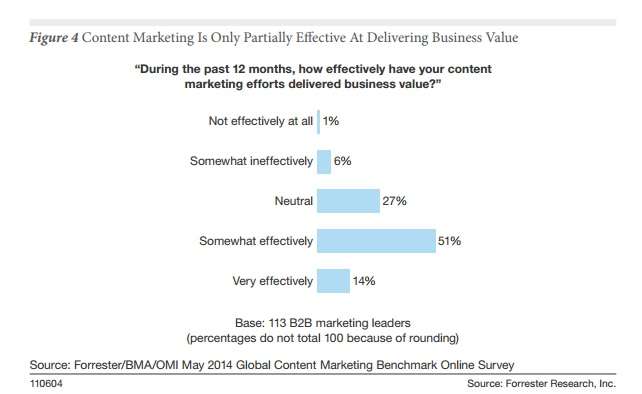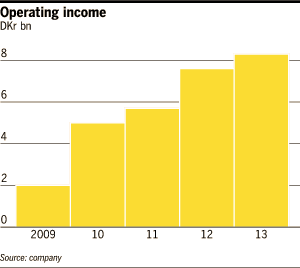Designing a logo for a tech firm? Use a cuddly animal
It worked for these guys. Can you name them all? Or indeed, any of them?
Posted in: Infographic of the day | Leave a Comment
It worked for these guys. Can you name them all? Or indeed, any of them?
Posted in: Infographic of the day | Leave a Comment
During a recent presentation for digital breakfast in London, a designer asked me how often one should use the human face in web design. I said, a lot. These eye-scan heat maps show where most people look, when they look at images. In the above Dolce & Gabbana ad, everyone looks at Scarlett Johansson’s face. In the ad below, and despite the model’s long beard, everyone still looks at the face.
 face.
face.
Not doing something can be riskier than doing it.
Posted in: Infographic of the day | Leave a Comment
As the table at the bottom of this post shows, despite widespread increases in content-marketing budgets, b-to-b marketers are still struggling to translate their content-marketing efforts into actual businesses results, according to a new study conducted by Forrester in conjunction with the Business Marketing Association and and the Online Marketing Institute.
Forrester VP Laura Ramos, who wrote the study, said: “Businesses doing a lot of things around content marketing, but they fully admit they don’t think it’s going that well.”‘
But they aren’t turning tail. In fact, as part of a separate b-to-b survey in Ad Age earlier late last year 75% of respondents said they would increase their content-marketing budgets in 2014.
“Some of the tools that we use — email marketing and marketing automation tools — give us a lot more power to reach out to customers, but we have to produce content to feed those tools and we’re not taking the steps to think about if this is the best content we can put out there,” said Ramos.
You can read the full piece here.

Lego’s digital strategy that rests on two principles, as reported in today’s Financial Times.
1. As Jørgen Vig Knudstorp, Lego’s chief executive, says :“If you’re good at authoring books, you’re not necessarily good at writing a movie script. ” That’s why Lego seek out partnerships with experts at movie making and computer games.
2. “We need to be much more agile in digital propositions,” says John Goodwin, Lego finance director. “Others put their games out in beta [an early development stage] and constantly reiterate it. That’s not part of our DNA. We have a tendency to want to have perfection by the time it gets into consumer hands.”
When Lego decided to launch an online game, it spent years planning and perfecting Lego Universe until its launch in 2010. But the game quickly fell flat and was killed off 18 months later, at the cost of about 115 jobs.
Around the same time, Markus Persson, a Swedish games developer, put out a test version of a game that he had developed in his spare time. That game became Minecraft, which is the biggest-selling PC game in history.
Lego do things differently now.

Posted in: Infographic of the day | Leave a Comment
Lego has just overtaken Mattel as the world’s largest toy company. The Lego formula appears simple: take plastic costing less than $1 per kilogramme and transform it into sets based on Star Wars, Legends of Chima or The Hobbit retailing for about $75 per kg.
But the company’s success – sales enjoyed compound annual growth of more than 20 per cent between 2008 and 2012 – is not just built on the humble plastic brick. It has branched out from toys into video games, board games and, most recently, film, with the highly successful The Lego Movie .
But as children spend more time playing on devices such as iPads and smartphones, Lego faces a big problem that has stalled rivals: can it keep up its stellar growth in an increasingly digital world of play, or will it be trapped by its own recent success?
Minecraft, a highly popular Lego-like computer game in which players build or destroy virtual landscapes made of building blocks, was created by the Swedish start-up Mojang. Some Lego executives privately regret that they failed to develop such a game.
CEO Mr Knudstorp praises Mojang, with whom the toymaker is developing several big Minecraft sets for release later this year.
“What we’re finding is that if you are very good at writing books, you are not necessarily the best to turn that book into a great movie. You need somebody who makes movies . . . and in our case we need partners who can translate the physical Lego experience into the digital experience,” he says.
Lego teamed up with TT Games, a British games developer, to make video games from Lego ranges such as Star Wars and Chima. Many became bestsellers and Lego has had success, too, with online games. It also partnered with Warner Bros to make The Lego Movie, which is the seventh-highest grossing film of the year, generating close to $500m globally.
“This movie signals they continue to want to expand from a construction toy to a content company. They can leverage that safe brand,” says Prof Robertson, a professor at the University of Pennsylvania’s Wharton School who has written a book on Lego, Brick by Brick.
But Mr Knudstorp says Lego will never become a fully digital company.
“The one thing is that we never leave the physical brick. Our standpoint is that physical play is extremely important. Then I see digital as an extra experience layer.”
He adds: “I guess we could be closer to a Nike, which is trying to obviously sell a very physical product like a sneaker or golfing equipment but may add an app that improves your golfing performance.”
Lego has not always done well. They were in a mess at the end of the 1990s for several reasons including a dizzying array of product launches and recruiting workers who lacked sufficient understanding of the company and its culture.
Some of those issues are now returning. Lego’s website lists 30 product ranges, while in February the company said it would focus on increasing staff in Connecticut, London, Shanghai and Singapore.
And growth is slowing at Lego. Sales increased 10 per cent last year, down from the breakneck average of 20 per cent in the previous five years. That is still better than many rivals in a gloomy toy market. Mattel’s sales rose 1 per cent in 2013 while Hasbro’s fell slightly.
Posted in: Big Picture story | Leave a CommentThere is a terrific piece ion today’s Guardian in which Glastonbury organiser Michael Eavis explains the debt Europe’s largest music festival owes to Clarks shoes and Quakerism.
Says Eavis: “But Quakerism also had an influence in that the Clarks [the shoe-making family, from Street in Somerset] are Quakers. My great-grandfather rented a farm from them. The non-conformist, Quaker thing was strong in mid-Somerset, and the Clarks had an influence on the politics and the planning of the neighbourhood. That’s why I’ve been allowed to get away with the festival. It succeeded only because of the support and influence of the Clarks and the Quaker/Methodist non-conformism here. It simply would not have succeeded anywhere else in Britain.”
To me, stories around pop music can often be more interesting than the music itself.
Posted in: Big Picture story | Leave a Comment
This map was drawn by Professor Joel Garreau in his 1981 book “The Nine Nations of North America.” Ever since it has been used by marketeers and politicians to get ahold of how North America divides.
“Check out the last few presidential election results at the U.S. county level, and these boundaries still pop right out at you. In Canada, it’s even more striking,” says Garreau today.
But not only is the Nine Nations a map of culture and values, but also a map decribing money, power and influence, “the patterns of which have only deepened.”
Posted in: Infographic of the day | Leave a Comment